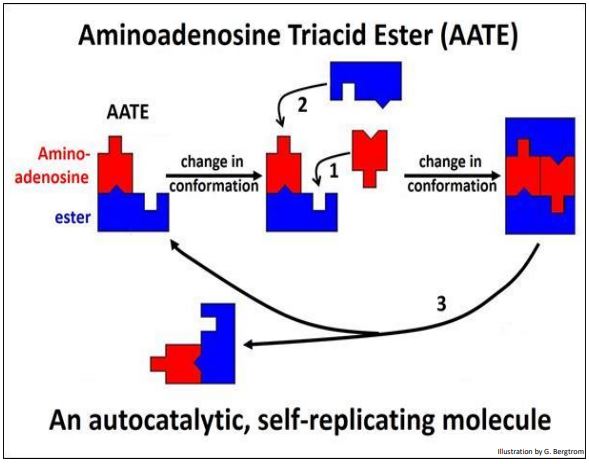72 Origins of Life Chemistries in an RNA World
In the tidal pool scenario, with its feel of ‘best-fit’ with origins of life in a reducing environment, the energy for polymer formation from organic monomers came from an overheated earth environment. In that scenario, we considered the possibility that chains of nucleotides might have been synthesized, and then even replicated to form populations of nucleic acids. But if the prebiotic environment was non-reducing, where would the energy have come from to make any polymers, let alone ones that could replicate themselves? If you guessed that the energy was provided by a proton gradient between biofilm-enclosed acidic proto-cells and an alkaline ocean…, you would have been right! In this case, then polymers would have been synthesized in enclosed spaces, and not in tidal pools only to be dispersed and diluted in the wider oceans. And then, how would replicative, informational and catalytic chemistries have arisen from these organic monomers and polymers? Polypeptides would have formed, but they have no inherent chemical or structural basis for self-replication. Unlike polypeptides, we saw in describing the tidal pool scenario that polynucleotides (nucleic acids) do! In fact, evidence is accumulating to support the increasingly accepted hypothesis that life originated in a RNA world:
- Today’s RNAs include ribozymes that catalyze their own replication (e.g., self-splicing introns).
- Some RNAs are part of ribonucleoproteins with at least co-catalytic activity (recall ribosomes, spliceosomes and the secretory signal recognition particle).
- Retroviruses (e.g., HIV) store their genetic information in RNA genomes that may have been integral to the emergence of cellular life.
Ribozymes, ribonucleoprotein structures and retroviruses may be legacies of a prebiotic RNA world. In fact, in an ‘in vitro evolution study’, self-replicating ribozyme polymerases in a test tube become more efficient at replicating a variety of increasingly longer and more complex RNAs over time.
There are hypothetical RNA world scenarios for the origins of replicating, catalytic polymers, and even a real organic chemical autocatalyst that can catalyze its own synthesis. So, which may have come first? A self-replicating RNA or some other selfreplicating molecule, even a self-replicating organic molecule? Arguably, chemical evolution of an autocatalytic RNA is a stretch, but at least one organic molecule, Amino-Adenosine Triacid-Ester (AATE), is a present-day self-replicating autocatalyst. Could an organic molecule like AATE have been a prebiotic prelude to the RNA world? The structure and replication of AATE are described below (Figure 1).

The replicative reaction proceeds in the following steps:
- The aminoadenosine triacid ester binds another molecule of aminoadenosine.
- The two aminoadenosines, now in opposite orientations, can attract and bind a second ester.
- After bond-rearrangements, the molecule separates into two molecules of AATE.
This reaction is catalytic because the stereochemistry of the reacting molecules creates an affinity of the aminoadenosine ester molecule first for an additional free aminoadenosine molecule, and then for a second free ester. The structure formed allows (i.e., catalyzes) linkage of the second aminoadenosine and ester followed by the separation of both AATE molecules. Subtle, sequential changes in the molecular conformation of the molecules result in the changes in affinities of the molecules for each other. In the replicative reaction, the AATE, free ester and free aminoadenosine concentrations would drive the reaction. Could AATE-like molecules have been progenitors of autocatalyzed polymer replication? Could replication of a prebiotic AATElike molecule have led to an RNA world? Could primitive RNAs have been stabilized by binding to short prebiotic peptides, becoming forerunners of ribozymes? The possibility of a prebiotic AATE-like molecule is intriguing because the ‘triacid’ includes a nucleotide base, the purine adenosine! On the other hand, the possibility of prebiotic replicating RNA-peptide complexes implies the origins of life in an RNA-Protein world (rather than exclusively RNA-world)! Whether life began in an RNA world or an RNA-protein world, catalyzed replication is of course another property of life.
Watch this video to learn about AATE: An Autocatalytic, Self-Replicating Organic Molecule.
This chapter by Gerald Bergtrom is licensed CC BY 4.0.

